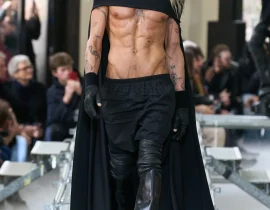Dear Diane and Shaded Viewers,
In its ability to latch onto everything, fashion at some point perhaps became a little lost, and inevitably with confusion comes insecurity. Jane Rapley OBE, retired Dean of Fashion and Textiles at Central Saint Martins, opened the conversation with her call-out to celebrate fashion for it’s own sake. ‘Over the last 50 years I think it's marvellous the way fashion was emerged from to becoming recognised for the real signifier that it is…it's become an incredible force in the economy.’ However, ‘we have now been moved into mainstream academia and I think we have a slight inferiority complex about this.’ ‘We are a design practice and we should be proud of that because we bring something profound…what we produce is experienced by people in a visceral way.’
Not only has fashion been questioned by people within the industry but also people who work with it. Diane Pernet spoke about the genesis of ASVOFF, the film festival in its 8th year (though longer than that if you count earlier versions under a different name), which came from a fear of film directors towards fashion. Perhaps it was a lack of understanding, or threat that the garments would takeover the shot, though in any case the festival now works to ‘support the exchange of the two mediums’.
The work of Armando Chant and Rickard Lindqvist lend themselves perfectly to this exchange. Chant is educator from the University of Technology, Sydney and creative practitioner, who uses film ‘to produce a contemplative feeling, that's not in line with the immediate nature of fashion.’ This engagement with memory and a prolonged moment was also something portrayed in the objects of Charlotte Goldthorpe’s installation, Absence.
Lindqvist is a Swedish fashion designer, researcher and trained tailor who considers movement and moving images as a new starting point to pattern cutting and design. ‘I've been looking at dressmaking pre-tailoring – how are saris draped or togas worn…It's about a framework and turning it totally around and ending up somewhere else.’ The Choreographed Garment by Ulrik Martin Larsen also explored this idea of the performance of a garment through free movement in his series of films, which were projected dichotomously in three compartmentalised spaces in the basement of Santa Croce.
It was indeed space, one of the major themes of IFFTI 2015 that was a focus of this discussion, with Diane explaining the changing reception of her festivals with respect to space, regardless of the content. Lisette Ros also reflected on the emotional detachment of spaces we consider intermediate – hallways, supermarkets, offices; non-places. Conversely, the charming installation by Bunka Gakuen University, Tokyo, Wearable Homes looked at how simple design can create feelings of comfort and shelter. (There’s a fun picture taken by Diane of Tim Blanks in one of these cardboard designs.)
The significance of emotions to free the creative process was the strongest sentiment from Head Of Design & Technology at Polimoda, Patrick De Muynck. Sharing his ideas, the French sociologist and philosopher Michel Maffesoli gave a wonderful guest lecture, in which he spoke of the collective unconscious and why the ‘Marxism of the world’ has created not an economic or political crisis, but a social crisis. In order to reset this, Maffesoli sees we need to no longer look at the value of work but of creation and creativity; ‘the importance of the immaterial.’
What comes with this value of creativity is the value of error. Rapley made it very clear that ‘when you're educating students in design practice, you have to let them practice and get things wrong.’ She explained that it’s about the younger generation challenging the core of fashion in order to ‘spin out from the centre and push at the boundaries.’ This idea was echoed by Armando Chant, who sees ‘there is a certain industry we learn about and can go into it. But also you can interact with other creative industries and form your own space. McQueen created his own space. We need to give designers the space… and allow them to exist in this overlap.’
Giving space.
It’s perhaps one of the simplest ideas, though a little more complex than it seems. Everyone involved in this conference is invested in doing exactly this – giving space – but I think there are moments of misalignment when it comes to application. I find myself feeling a little uncomfortable when other generations speak on the behalf of young people; how we’re feeling, how we’re coping, or not. And this is symptomatic of a greater problem when luxury houses are being renewed with star designers and only occasionally does a Craig Green kind of situation happen – someone who has indeed been given space to flourish.
Ou Ning in collaboration with Moleskine and Lettera27 absolutely did this during the conference. In an exploration of ‘how to make ideas happen’, Ning briefed a handful of design students in the Galileo Room of the National Library. Within the boundaries of an empty notebook, the students then expressed their creativity in any way they wished, which in the end was worthy of their own Moleskine exhibition.
Happy Sunday,
Sophie

![]()



